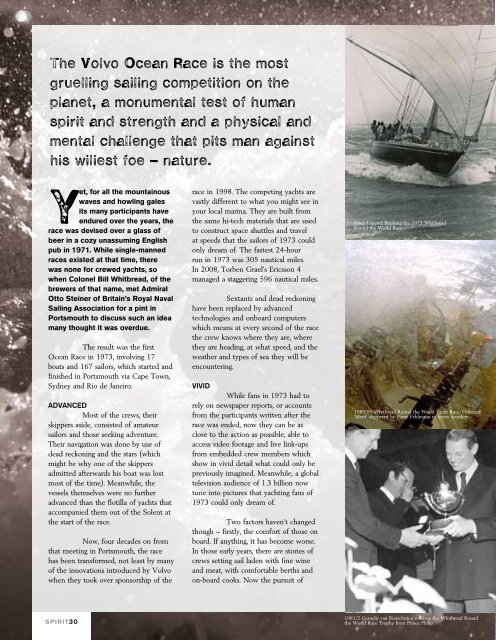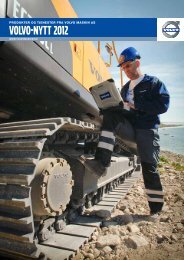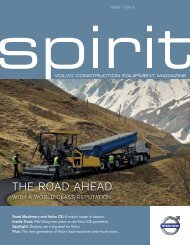Spirit 43 - Volvo Construction Equipment
Spirit 43 - Volvo Construction Equipment
Spirit 43 - Volvo Construction Equipment
Create successful ePaper yourself
Turn your PDF publications into a flip-book with our unique Google optimized e-Paper software.
The <strong>Volvo</strong> Ocean Race is the mostgruelling sailing competition on theplanet, a monumental test of humanspirit and strength and a physical andmental challenge that pits man againsthis wiliest foe – nature.Yet, for all the mountainouswaves and howling galesits many participants haveendured over the years, therace was devised over a glass ofbeer in a cozy unassuming Englishpub in 1971. While single-mannedraces existed at that time, therewas none for crewed yachts, sowhen Colonel Bill Whitbread, of thebrewers of that name, met AdmiralOtto Steiner of Britain’s Royal NavalSailing Association for a pint inPortsmouth to discuss such an ideamany thought it was overdue.The result was the firstOcean Race in 1973, involving 17boats and 167 sailors, which started andfinished in Portsmouth via Cape Town,Sydney and Rio de Janeiro.AdvancedMost of the crews, theirskippers aside, consisted of amateursailors and those seeking adventure.Their navigation was done by use ofdead reckoning and the stars (whichmight be why one of the skippersadmitted afterwards his boat was lostmost of the time). Meanwhile, thevessels themselves were no furtheradvanced than the flotilla of yachts thataccompanied them out of the Solent atthe start of the race.Now, four decades on fromthat meeting in Portsmouth, the racehas been transformed, not least by manyof the innovations introduced by <strong>Volvo</strong>when they took over sponsorship of therace in 1998. The competing yachts arevastly different to what you might see inyour local marina. They are built fromthe same hi-tech materials that are usedto construct space shuttles and travelat speeds that the sailors of 1973 couldonly dream of. The fastest 24-hourrun in 1973 was 305 nautical miles.In 2008, Torben Grael’s Ericsson 4managed a staggering 596 nautical miles.Sextants and dead reckoninghave been replaced by advancedtechnologies and onboard computerswhich means at every second of the racethe crew knows where they are, wherethey are heading, at what speed, and theweather and types of sea they will beencountering.VividWhile fans in 1973 had torely on newspaper reports, or accountsfrom the participants written after therace was ended, now they can be asclose to the action as possible, able toaccess video footage and live link-upsfrom embedded crew members whichshow in vivid detail what could only bepreviously imagined. Meanwhile, a globaltelevision audience of 1.3 billion nowtune into pictures that yachting fans of1973 could only dream of.Two factors haven’t changedthough – firstly, the comfort of those onboard. If anything, it has become worse.In those early years, there are stories ofcrews setting sail laden with fine wineand meat, with comfortable berths andon-board cooks. Now the pursuit ofKings Legend, finishing the 1973 WhitbreadRound the World Race.1989/90 Whitbread Round the World Yacht Race: Onboard‘Merit’ skippered by Pierre Fehlmann in heavy weather.SPIRIT301981/2 Cornelis van Rietschoten receives the Whitbread Roundthe World Race Trophy from Prince Philip.
















